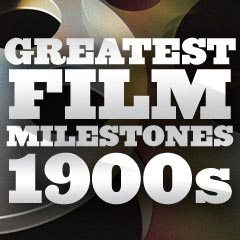
|
Milestones and Turning Points in Film History The Year 1909 |
![]()
(by decade and year) Introduction | Pre-1900s | 1900s | 1910s | 1920s | 1930s | 1940s | 1950s 1960s | 1970s | 1980s | 1990s | 2000s | 2010s | 2020s |
| Event and Significance | |
| There were about 9,000 movie theaters in the United States. The typical film was only a single reel long, or ten- to twelve minutes in length, and the performers were anonymous. Acting in a movie was looked upon as degrading compared with stage acting, so actors were never identified by name. | |
| The Selig Polyscope Company established the first permanent film studio in the Los Angeles area, at 1845 Allesandro Street (now Glendale Blvd.) in Edendale [present day Echo Park]. The first dramatic film to be completely made on the West Coast, in Los Angeles, California, was debuted by Selig - In the Sultan's Power (1909) by director Francis Boggs. | |
| The first feature-length film produced in the US was Vitagraph's Les Miserables (1909) (each reel of the four-reel production was released separately over a two-month period) - it was based on Victor Hugo's novel. | |
| The New York Times published its first movie review on October 10, 1909 - a report on D.W. Griffith's Pippa Passes; or The Song of Conscience (1909). | |
| The first 'independent' film, arguably, was released as the first film from the newly-established IMP Company (Carl Laemmle's Independent Moving Picture Company (IMP)), founded in 1909 and located in NYC and Fort Lee, NJ. The film was the one-reel Hiawatha (1909). IMP was not affiliated with the Motion Picture Patents Company (MPPC) newly-formed in 1908. [Note: Laemmle's company eventually became Universal Pictures.] | |
| Director D. W. Griffith's Biograph short A Corner in Wheat (1909) marked the first use of "freeze-frame" (actually an extended, static tableau of actors standing motionless) for jarring, dramatic effect in a shot of a breadline at a bakery. It also included an early instance of contrasting, parallel action cross-cutting. | |
| The New York Times coined the term 'stars' for leading movie players. | |
| Director Siegmund Lubin, the first Jewish-American film-maker, shot the dramatic short 3 minute film The Yiddisher Boy (1909). It was notable as the first film with a flashback, showing a boyhood street fight with thugs 25 years earlier on the Lower East Side. The paths of the two individuals (Moses and Ed) involved in the fight would cross 25 years later. | |
| An American court ruled that unauthorized films infringed on copyrights, in a case over an early film version of Ben-Hur (1907). As a result, film companies began buying screen rights to books and plays. | |
| Broadway star Mary Pickford signed on to appear in D.W. Griffith's (and Biograph) 10-minute short silent drama The Violin Maker of Cremona (1909), an Italian costume piece. It was Pickford's second film, although her first credited film. [She had earlier appeared as an extra in Her First Biscuits (1909), a comedy starring the first "Biograph Girl" Florence Lawrence.] In 1909 alone, Mary Pickford played 45 film roles for D.W. Griffith. | |
| Comedian Ben Turpin was mentioned in a trade journal, and became the first American film actor to have his name published. | |
| Cameraman Billy Bitzer became the first to film entirely indoors using artificial light. | |
| 35 mm width with 4 perforations per frame was recognized as the international standard film gauge. It has remained the dominant film gauge since that time. | |
| Siegmund Lubin sold his chain of theaters, incorporated the Lubin Manufacturing Company, Inc., and built a huge new film studio in North Philadelphia, called "Lubinville" (which he began to occupy in 1910). |